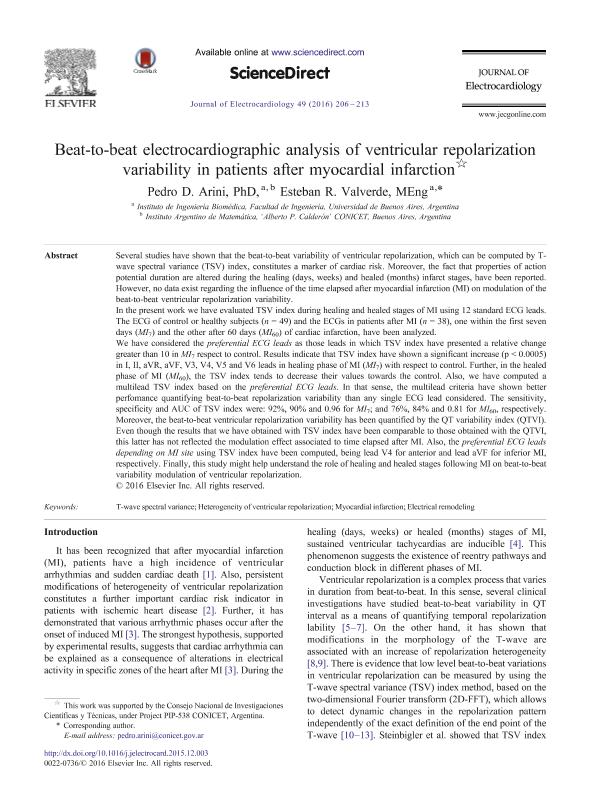Artículo
Beat-to-beat electrocardiographic analysis of ventricular repolarization variability in patients after myocardial infarction
Fecha de publicación:
03/2016
Editorial:
Churchill Livingstone Inc Medical Publishers
Revista:
Journal of Electrocardiology
ISSN:
0022-0736
Idioma:
Inglés
Tipo de recurso:
Artículo publicado
Resumen
Several studies have shown that the beat-to-beat variability of ventricular repolarization, which can be computed by T-wave spectral variance (TSV) index, constitutes a marker of cardiac risk. Moreover, the fact that properties of action potential duration are altered during the healing (days, weeks) and healed (months) infarct stages, have been reported. However, no data exist regarding the influence of the time elapsed after myocardial infarction (MI) on modulation of the beat-to-beat ventricular repolarization variability. In the present work we have evaluated TSV index during healing and healed stages of MI using 12 standard ECG leads. The ECG of control or healthy subjects (n = 49) and the ECGs in patients after MI (n = 38), one within the first seven days (MI7) and the other after 60 days (MI60) of cardiac infarction, have been analyzed. We have considered the preferential ECG leads as those leads in which TSV index have presented a relative change greater than 10 in MI7 respect to control. Results indicate that TSV index have shown a significant increase (p < 0.0005) in I, II, aVR, aVF, V3, V4, V5 and V6 leads in healing phase of MI (MI7) with respect to control. Further, in the healed phase of MI (MI60), the TSV index tends to decrease their values towards the control. Also, we have computed a multilead TSV index based on the preferential ECG leads. In that sense, the multilead criteria have shown better perfomance quantifying beat-to-beat repolarization variability than any single ECG lead considered. The sensitivity, specificity and AUC of TSV index were: 92%, 90% and 0.96 for MI7; and 76%, 84% and 0.81 for MI60, respectively. Moreover, the beat-to-beat ventricular repolarization variability has been quantified by the QT variability index (QTVI). Even though the results that we have obtained with TSV index have been comparable to those obtained with the QTVI, this latter has not reflected the modulation effect associated to time elapsed after MI. Also, the preferential ECG leads depending on MI site using TSV index have been computed, being lead V4 for anterior and lead aVF for inferior MI, respectively. Finally, this study might help understand the role of healing and healed stages following MI on beat-to-beat variability modulation of ventricular repolarization. Highlights To understand the relationship between healing and healed infarct phases and the beat-to-beat ventricular repolarization variability.Analyze the healing and healed miocardial infarction phases using TSV index method.Study the preferential ECG leads to compute the TSV index in these stages and quantify the sensitivity and specificity of this method.
Archivos asociados
Licencia
Identificadores
Colecciones
Articulos(IAM)
Articulos de INST.ARG.DE MATEMATICAS "ALBERTO CALDERON"
Articulos de INST.ARG.DE MATEMATICAS "ALBERTO CALDERON"
Citación
Arini, Pedro David; Valverde, Esteban Raul; Beat-to-beat electrocardiographic analysis of ventricular repolarization variability in patients after myocardial infarction; Churchill Livingstone Inc Medical Publishers; Journal of Electrocardiology; 49; 2; 3-2016; 206-213
Compartir
Altmétricas




